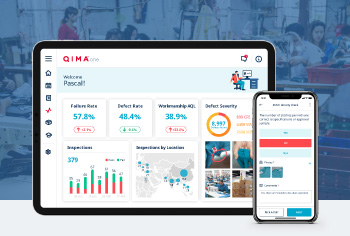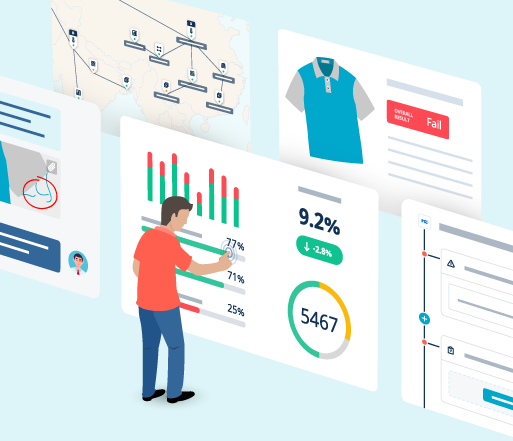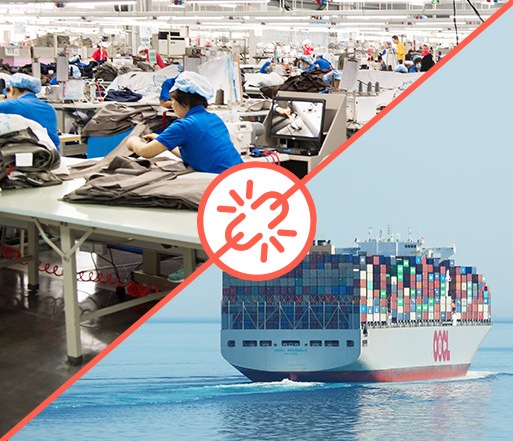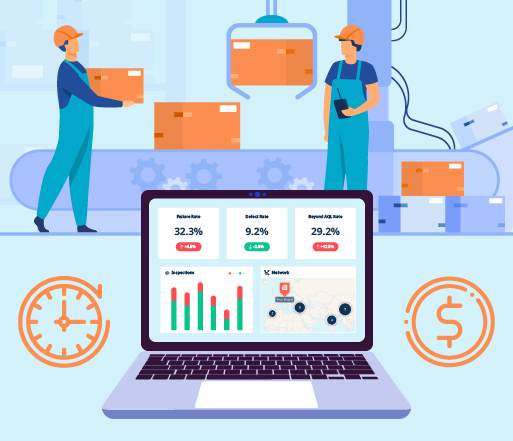
Article
How to Implement a Quality Management System

Article
How to Implement a Quality Management System
Article
How to Implement a Quality Management System

Keep up-to-date with the latest supply chain insights.
In today's increasingly competitive marketplace, a quality management system (QMS) is essential for helping companies maintain and attain high levels of product excellence. While many companies are using new digital tools to ensure quality production across their supply chain, knowing how to implement a quality management system is just as important as the tools you use.
When you implement a quality management system successfully, it's like constructing a bridge that will take your company from uncertainty to consistency. But building that bridge to consistent quality can be daunting, at first.
In this article, we will consider the importance of a well-implemented quality management system (QMS), essential features that will maximize QMS effectiveness, and how to implement a quality management system.
Key Takeaways
- Importance of a QMS: Implementing a quality management system helps consolidate supply chain data and organize it to allow for actionable insights.
- What a QMS Requires: An effective quality management system requires clear standards and goals, an easy-to-use platform, and standardized documentation practices.
- How to Implement a QMS: There are five key steps in implementing a quality management system, including identifying key performance indicators, mapping your supply chain, and building best practice guides.
Why Is Implementing a Quality Management System Important?
During the Industrial Revolution, the majority of quality inspections could physically be performed under one roof. That changed in the twentieth century as assembly lines and supply chains grew. Companies saw parts manufactured separately from finished products, and raw materials sourced farther away and in greater quantities to meet growing customer demand.
This led to the creation of Total Quality Management (TQM) when quality control (QC) inspections expanded to cover quality guarantees at each stage of the production process, including the verification of raw materials.
As outsourcing gained steam and supply chains spread out across the globe, a gap widened between TQM complexity and an effective means of keeping inspection data and factory compliance documentation in order.
Fortunately, technology has been catching up over the new century. Companies are taking advantage of emerging software designed to consolidate end-to-end supply chain information and organize it into actionable data that can drive improvement across the supply chain.
Read more: What is Quality Control Management Software in the Supply Chain?
QMS Meets Internal and External Needs
Knowledge of how to implement a quality management system can adequately address behind-the-scenes manufacturing processes and public demands.
Digitalized Processes
Day-to-day production, raw material procurement, farm, and factory practices all have corresponding QA/QC guidelines, market regulations, safety protocols, and ethical standards.
Ensuring that a twenty-first-century supply chain follows all these requirements would be impractical using twentieth-century methods likepaper and spreadsheet inspection forms, disparate management systems, and siloed data chambers.
One overlooked link is enough to put the entire chain at risk, so the implementation of a cloud-based QMS software with expert-designed quality and compliance features is your best bet for maintaining control over countless day-to-day details.
Customer Requirements
Not only are internal processes growing more complex but Customer-led quality expectations, as well as ethical considerations, such as fair labor practices and environmental management, are also becoming more sophisticated--to the point where customer retention and brand loyalty have become the most important signs of supply chain effectiveness and transparency.
Without visibility and agency over every aspect of your supply chain's internal processes, it is impossible to guarantee consistent quality or ethical adherence to the public. Today's customers are more willing than ever to spend extra when these guarantees can be provided.
What Does a Quality Management System Require?
- Clear Standards and Goals : The expectations you have for quality workmanship, efficient product delivery, and ethical practices should be outlined in detail and made available to every supplier, manufacturer, vendor, warehouser, and stakeholder in your operation.
- An Easy-To-Use Platform : The quality management system must include
- A dashboard of immediate action alerts
- Inspection task assignments -- by product, test, inspector, and date
- Inspection workflows for inspectors to follow
- Report results -- Approved and rejected
- Data analysis and statistics per supply chain facility, such as failure-rate
- Organized contact information for all supply chain managers and inspectors
- Network access through any mobile device (or a dedicated mobile inspection app)
- Access to best practice training courses
- Documentation : Standardized, up-to-date, and easily accessible documentation of every product test and factory inspection. Plus, necessary certification must be stored and maintained to prevent non-compliances from going unaddressed.
How to Implement a Quality Management System?
Right from the start, implementation needs to happen in a comprehensive fashion, backed by technical support and industry expertise.
Alternatively, implementing a QMS piecemeal can lead to confusion and loss of confidence in your supply chain management.
Therefore, before quality management system implementation can start, preparation should focus on:
- Organizing mission statements
- Standardizing and updating inspection templates
- Developing training tools and best practice manuals
- Translating all materials into appropriate languages
The following are the key steps in implementing a quality management system:
- Define the scope of the QMS by identifying all areas of your business that relate to quality and specifying their requirements under the QMS. What does quality look like for your products and each stage of the supply chain?
- Identify all metrics required to monitor your performance in meeting those quality requirements. What are your key performance indicators (KPIs)? Understanding which metrics to track – and where you’re starting from – will allow you to measure the success of your QMS in the future.
- Measure how well tasks are being completed using those metrics and make adjustments as needed.
- Implement a training program for suppliers on how to perform their jobs effectively under the QMS. This will help them understand how their actions affect overall performance levels within your organization's supply chain structure.
- Perform supply chain mapping to ensure that every partner is aware of their responsibilities, production goals, existing inspection results, and certification requirements (obtained or outstanding).
- Before distributing materials such as inspection templates and best practice guides, get them reviewed by industry and Testing, Inspection, and Certification (TIC) service experts to ensure validity and coverage of all relevant points.
Start your digital journey with QIMAone
Try for free today!
Start your digital journey with QIMAone
Try for free today!QMS Implementation Should Enhance Supply Chain Communication
A streamlined QMS software with features such as automated inspection scheduling and report data consolidation will seriously boost efficiency.
That being said, knowing how to implement a quality management system goes beyond automation and file consolidation. A QMS is only as successful as the people who can effectively work within a system's parameters.
Therefore, it is vital to maintain open lines of communication to allow general feedback, individual concerns, and new, innovative ideas. An integrated communication platform with open-channel communication will give your partners the opportunity to bring their experience to the table.
This will also stop uncommunicated frustrations from building up and slowly disconnecting you from your talented supply chain.
Allow Time for Implementation to Take Hold
Implementing changes to a supplier or vendor's current working methods often requires an adjustment period, either to allow workers to understand the new platform or work past their initial skepticism.
A comprehensive, easy-to-understand platform equipped with tools and training will assuage any doubts about your updated system, and it will boost confidence in your company's ability to bring quality products to market in the most efficient and transparent way possible.
Talented suppliers, vendors, and warehousers will always recognize serious-minded companies and will be immediately compelled to attach their operations to its brand.
What Makes a Quality Management System Effective?
A quality management system’s effectiveness hinges upon the following factors:
- Specific quality and compliance features
- Ease of use
- Technical support
- Product-specific expertise and input
- Organized implementation
Beyond the right platform, how you implement a quality management system will also go a long way to instill confidence in your partners, in that:
- They can trust your ability to guide a product from source to shelf, and
- They can raise their own profile through your platform, and in turn, make better business choices moving forward.
How Can QIMAone Help?
QIMAone end-to-end quality and compliance software is the perfect complement to any existing QMS because it brings all of your TIC matters together under one digital roof.
Our ease-of-use format can help you first organize your specific documents, training tools, inspection templates, and workflows into an organic whole well in advance of implementation, so you can feel certain that no detail or direction goes overlooked.
Additionally, our supplier quality management software is backed by both technical support as well as TIC service experience spanning over 15 years. You can be sure that our off-the-shelf inspection and auditing templates conform to the latest market regulations.
The past two decades have seen rapid changes in both product industry regulations as well as technological breakthroughs. QIMA and QIMAone have been a vital part of those changes, and we are ready to share our knowledge and help you implement it into your QMS.
Want to see how it works?
Learn more about QIMAone applications by scheduling a demo today.
Most Popular Articles
Corrective Action Plans 101: Your Basic Guide to Ensuring Supply Chain Quality Excellence
The Benefits of a Data-Driven Supply Chain
6 Benefits of Supply Chain Visibility
How to Implement a Quality Management System
Simpli Home: Ensuring product quality and compliance with supply chain technology
7 Effective Ways to Improve Your Quality Management System
Supply Chain Visibility: Complete Guide for Supply Chain Managers
Boost Quality Control with Supplier Performance Metrics


















